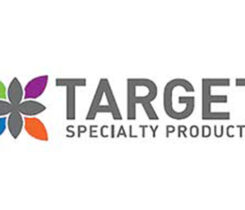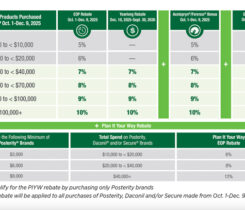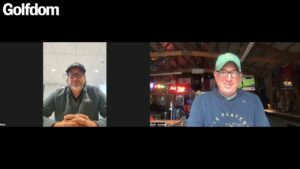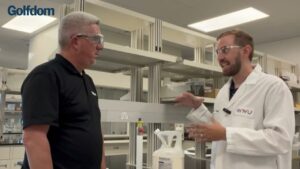Navigating Early Order Program season
 When it comes to Early Order Programs, the month of October is major league. Who will take the crown?
When it comes to Early Order Programs, the month of October is major league. Who will take the crown?
He has no batting average, no bullpen and definitely no WHIP rating. Likewise he has no assists, hasn’t been checked into the boards and last we heard, he hasn’t been assessed any penalty minutes.
But Scott Waltz does have one thing in common with those players in both the National Hockey League and Major League Baseball lucky enough to advance to their respective playoffs: He has a playoff beard.
“I really do look at EOP like the playoffs. Last year I started growing my beard out on September 1st and grew it all the way till the end of EOP,” Waltz, a sales representative for BASF covering eastern Pennsylvania, says. “It drew a lot of attention and I told people I wasn’t going to shave till the end of EOP, just like the players don’t shave in hockey.”
Waltz says that his playoff, er, EOP beard, will make its return in 2016. He and his fellow golf sales professionals around the country look at the Early Order Program sales cycle as their World Series or their Stanley Cup.
Who will hoist the trophy at the end of the 2016 EOP playoffs? Superintendents around the country will be, if they follow some suggestions offered by these three turf sales professionals from around the country…
A planning mentality
Stephanie McKay is an account manager for Nufarm Americas, based in Florida. She was hired right out of college (University of Florida) and has been representing Nufarm in Florida for about four years.
That’s long enough for her to realize how important the EOP process is to the golf course superintendents.
“Everyone wants to know what the program is, how they can save money for their customers and take advantage of all the offerings we have,” McKay says. “I’m in a nice situation where Florida is a consistent buying season. While that’s a huge advantage, there is a difference between EOP season and, say, springtime. There’s definitely more of a planning mentality right now.”
McKay tries to see three or four customers in a day. Because she covers the entire state of Florida, she often leaves on Tuesday and doesn’t return home until Friday. She says because her golf customers are all extremely excited to discuss the EOP offerings, it’s her job to keep things simple.
“I know my distribution channel; not only are they selling my Early Order Program, they are selling my competitor as well,” McKay says. “So if we can make it an easy process for them, the better it is for us.”
Calendar marked for October 1
JJ Jansen works in central Texas, representing Harrell’s. He’s been selling to the region for about four years. Prior to his job with Harrell’s, he was a superintendent, so he knows how important the EOP process is for his customers.
He tries to visit four to five customers each day. It’s his personal policy not to arrive anywhere unannounced — he remembers how much that irked him when he was a superintendent.
Jansen likes the idea of an EOP playoff beard. If he were to do it, he knows what day he’d start it.
“October 1 is the big day because that’s when all of the manufacturer programs start — Syngenta, Bayer, BASF, Nufarm, Dow, all those guys,” he says. “October is by far the busiest month of the year. In September I’m going around seeing guys from our program but I’m printing out copies for the guys and looking at what they did last year. I spend a few days in September sitting down at the computer, making spreadsheets and printing stuff out for customers in preparation.”
Though it might not feel like fall in Texas, he recognizes EOP season is his playoffs season.
“For me it’s a way to go to a customer and sit down with their budget and help them plan for the year,” he says. “It’s huge, man. Not only am I going in there but other suppliers are going in there, as well.”
Good advice
We asked Waltz, Jansen and McKay to ponder this question: What do superintendents need to do to have a successful Early Order Program season?
“We don’t design these programs just to do something with our time. There’s truly some savings, there’s truly an opportunity to take advantage of the programs,” McKay said. “The best advice I can give is to be proactive as possible. Do as best as you can to plan what you know is going to happen, the products that you need. If there are going to be new products out there you want to try and there’s an offering, go for it. If there are products you are always going to use, take advantage of the offerings as well and load up.”
Waltz advises superintendents to “get the biggest bang for their buck.”
“The superintendents need to know what problems they have and what products are going to solve them. All the companies make great products that can solve a lot of different questions for them, but for me how do you maximize the programs?” Waltz asks. “For example, for me the (BASF) cubes are such a smart deal. We create them with the superintendent in mind. We have certain ones that are just for greens programs and we have others that are just for fairway programs. We even have one that is for the naturalized area on the golf course. We spend a lot of time putting those together so that it’s the biggest bang for the superintendent’s buck.”
The saying is that ‘time is money,’ but for Jansen, he wants his customers to spend his time freely.
“It’s nothing for me to spend two hours with a customer,” he says. “(I) look at what they did last year. What can we improve on? How can we maximize (the) budget so we’re locking in prices? Because inevitably prices will go up whether it be in October or in the first of the year.
“If you can get into a superintendent’s office and show them exactly what they did last year and ask them what worked,” he continues, “…if you do that it makes it simple for the superintendent.”
Golfdom Asked
What are you most looking forward to selling in your 2016 EOP?
“Bayer’s new nematicide, Indemnify. It’s a new tool that we haven’t had, and from all the data and research that I’ve seen it’s going to be the latest and greatest when it comes to fighting nematodes. I think this is going to be a game-changer.” — JJ Jansen
“We’re launching a liquid version of Sureguard, which is a really great pre-emergent and some post-emergent activity herbicide. We also launched Aloft back into Florida, so that was a huge success to have that back — along with Arena — those are really great products for southern chinch bugs.” — Stephanie mckay
“I am really going to focus on Lexicon for Waitea and fairy ring. This has been a great product with dual mode of action on two new diseases that will be added to the 2017 label. With Lexicon you have a product that really covers you on 99-percent of the diseases you would encounter on your greens. It gives superintendents peace of mind they can use one product that will cover all the issues they face.” — Scott waltz
Photo: Golfdom












